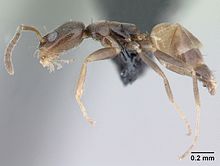
Dolichoderinae is a subfamily of ants, which includes species such as the Argentine ant, the erratic ant, the odorous house ant, and the cone ant. The subfamily presents a great diversity of species throughout the world, distributed in different biogeographic realms, from the Palearctic, Nearctic, Afrotropical region and Malaysia, to the Middle East, Australian, and Neotropical regions.

Amyrmex golbachi is a rare Neotropical species of ant and the only known species in the genus Amyrmex. It is currently only known from males from the Amazon basin of Brazil and from northern Argentina.
Tatrasuchus is an extinct genus of temnospondyl amphibian from the Middle Triassic of Poland. It is classified as a member of the family Cyclotosauridae or Mastodonsauridae. It is closely related to the genus Cyclotosaurus. The type species, Tatrasuchus kulczyckii, was named in 1996. Damiani (2001) considered genus Kupferzellia Schoch (1997) from Middle Triassic of Germany to be a junior synonym of Tatrasuchus, and recombined its type species, K. wildi as the second species of Tatrasuchus. This classification was followed by some authors, e.g. Fortuny et al. (2011); other authors, e.g. Schoch (2008), maintain Tatrasuchus and Kupferzellia as distinct genera.

Forelius is a Neotropical genus of ants in the subfamily Dolichoderinae. The genus is known from southern United States to Argentina.
Forelius albiventris is a species of ant in the genus Forelius. Described by Forel in 1912, the species is endemic to South America.
Forelius andinus is a species of ant in the genus Forelius. Described by Kusnezov in 195, the species is endemic to Argentina.
Forelius bahianus is a species of ant in the genus Forelius. Described by Cuezzo in 2000, the species is endemic to Brazil.

Forelius brasiliensis is a species of ant in the genus Forelius. Described by Forel in 198 the species is endemic to South America.
Forelius breviscapus is a species of ant in the genus Forelius. Described by Forel in 1914, the species is endemic to Argentina.
Forelius chalybaeus is a species of ant in the genus Forelius. Described by Emery in 1906, the species is endemic to Argentina.
Forelius grandis is a species of ant in the genus Forelius. Described by Forel in 1912, the species is endemic to Argentina.
Forelius keiferi is a species of ant in the genus Forelius. Described by William Morton Wheeler in 1934, the species is endemic to Mexico.
Forelius lilloi is a species of ant in the genus Forelius. Described by Cuezzo in 2000, the species is endemic to Argentina.
Forelius macrops is a species of ant in the genus Forelius. Described by Kusnezov in 195, the species is endemic to Argentina.

Forelius nigriventris is a species of ant in the genus Forelius. Described by Forel in 1912, the species is endemic to South America.

Forelius pruinosus, commonly known as the high noon ant, is a species of ant in the genus Forelius. Described by Roger in 1863, the species is endemic to North America and has been recently observed in Latin America.

Forelius pusillus is a species of ant in the genus Forelius. Described by Santschi in 1922, the species is endemic to South America.
Forelius rubriceps is a species of ant in the genus Forelius. Described by Gallardo in 1916, the species is endemic to Argentina.
Forelius rufus is a species of ant in the genus Forelius. Described by Gallardo in 1916, the species is endemic to Argentina and Bolivia.
Selenocara is an extinct genus of mastodonsauroid temnospondyl. The type species is Selenocara groenlandica, described by Gunnar Säve-Söderbergh in 1935 on the basis of skull bones from the Lower Triassic Wordie Creek Formation of Greenland. Säve-Söderbergh originally described it as a new species of Wetlugasaurus.






